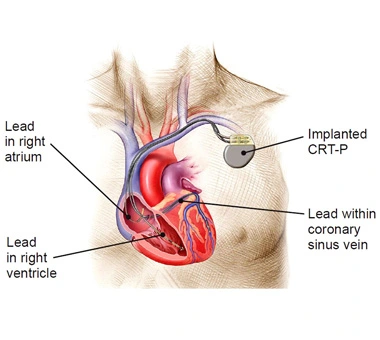
Cardiac Resynchronization Therapy is a treatment option in which a device is inserted in the heart which enables the heart, especially its lower chambers to pump blood better into the body. A biventricular pacemaker is inserted which helps both the ventricles to pump blood at the same time in a coordinated manner.
CRT is done mainly in cases of heart failure, when the pumping capacity of the lower chambers is impaired. Additionally, some CRT devices have an implantable cardioverter defibrillator (ICD) which can help revert life-threatening heart rhythms to normal state.

CRT is recommended for patients of heart failure with NYHA Class III or IV who remain symptomatic despite optimal medical management, with prolonged QRS and left ventricular heart function below 35%. In patients who need pacemaker for other indications and have heart function less than 50%, they can also be considered for CRT device as well.
Diagnostics
CRT, as mentioned previously, is done in patients of impaired heart functioning (LVEF less than 35%), whereas, Implantable Cardioverter Defibrillator (ICD) is inserted for patients having history of (or having high risk of) abnormal life threatening heart rhythm in the form of ventricular tachycardia or fibrillation.
If patients have a high risk of ventricular tachycardia and their heat pumping is low, then may qualify for a combined device of CRT and ICD called CRT D (CRT plus defibrillation). If only CRT is needed it is also called as CRT P (CRT plus only pacing).
Post-procedural Care and Monitoring
Immediate post-implantation care
These patients are shifted to the ICU and X ray of chest is done to see for any injury to the heart or lungs and to see the lead positioning. Antibiotics are also continued for a few days to prevent infections.
Long-term follow-up and device monitoring
CRT insertion patients have to be under lifelong surveillance. At least yearly follow up and device check needs to be done. Heart failure medicines need to be titrated as needed. If patients have new symptoms or observe fever or swelling at the device site, they should immediately see the doctor.
Early Complications
Late Complications
CRT devices have good evidence of improving the symptoms of the patients. Many patients have improvement in heart function post device insertion. With this not only the quality of life is better, but also the survival rates are improved.
Challenges and Limitations of CRT
Patient selection is paramount in CRT insertion. If indications are not right, the improvement post CRT insertion is questionable. Long term management and device checks are needed for these patients. Cost is also an understandable issue and also the doctors have to be duly qualified to do these procedures to give best possible outcomes and least complication rates.
CRT in Patients with Comorbidities
There are no alarming contraindications for CRT implantation. If the indication fits in and we expect that patients may live for more than a year, we can offer them CRT devices to aid in treating heart failure better in these patients.